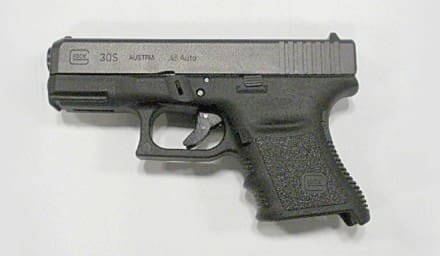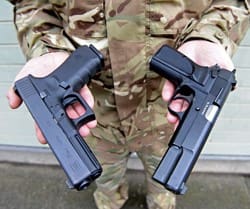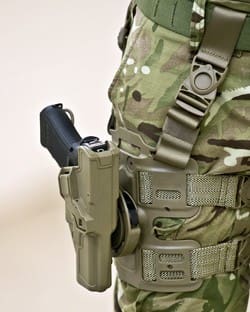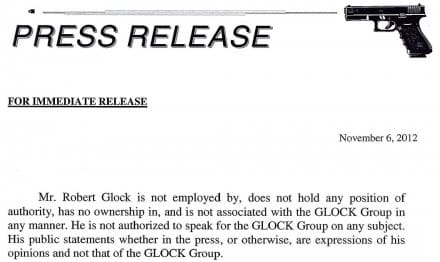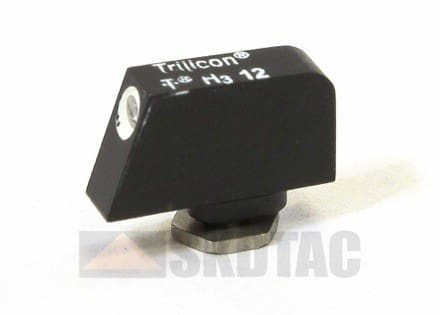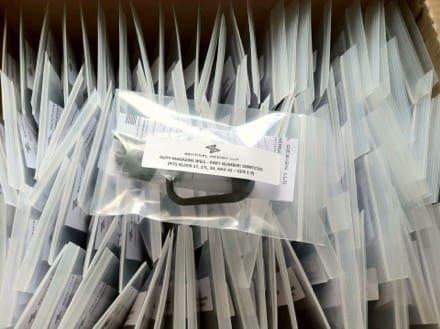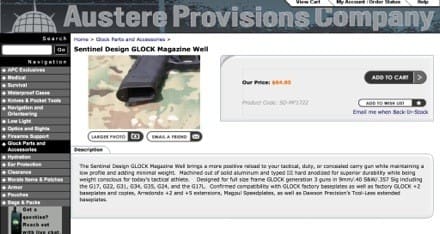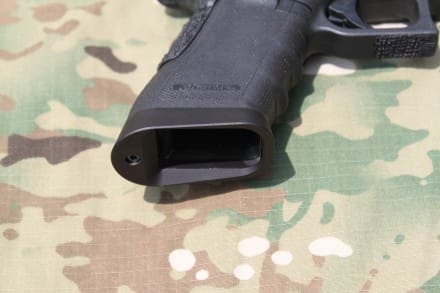Since the invention of the handgun in the 15th century mankind has been steadily improving the concept to what we are familiar with today. It is quite possible that we are at a point where the notch-and-post sight configuration has reached it maximum potential, and red-dot sights for the handgun are becoming more mainstream. This is a great trend for shooters for a number of reasons, but it also has a number of drawbacks that should be understood to ensure you have the capability you need when you need it.
Red dots on handguns might be more prevalent now than ever before, and that is certainly the case for tactical use. However, it’s nothing new, and competition shooters have been aware of the benefits of the red dot for speed and accuracy for decades. As far back as the 1960’s, bullseye shooters experimented with the Burris Bullseye Pistol Scope, and in 1975 Swedish manufacturer Aimpoint released the “Aimpoint Electronic”. Following these in the late 80’s was the wildly popular Tasco ProPoint and C-More, both of which are still available today. One does not have to look too hard to find any number of Aimpoint or C-More optics in the hands of thousands of competitive shooters around the world. These systems are remarkably effective for their purposes, but due to their size and durability were not practical for duty use.
For military/law enforcement/concealed carry use, the trend has just started to gain popularity over the last few years. The Glock and Smith and Wesson M&P series lend themselves to being modified for direct acceptance of small red-dots. Additionally, dovetail adapters for many platforms are available that do not require costly permanent modification to the pistol. David Bowie of Bowie Tactical Concepts was an early adopter of small red-dot sights for duty use, as well as a pioneer in the machining of handgun slides to directly mount the sights. Due to the fragile nature of some older sights, adoption by Military and Law Enforcement users was slow-paced for a few years. Recently, with the release of viable optics by industry leaders, their use has skyrocketed and resulted in a huge growth in the development of mounting systems and support products.
The mini-red dot has a lot going for it. It works the same as the Aimpoint or EoTech most people are familiar with on their rifles: Put dot on target, apply fundamentals. You can maintain focus on your target instead of the sight, which is something many shooters struggle with. It removes the variable of aligning the rear notch and front post precisely on target, although it certainly does not make up for poor shooting ability and in no way acts as a substitute for solid shooting technique. In fact, the new user will likely experience a period of growing pains where the dot is difficult to initially acquire, possibly gets lost in recoil, and is generally slower than when shooting irons until they become familiar with it. Once the average shooter is familiar with using the new system they are likely to see improvement all around, although skills of high-level competitive shooters are at a level where they are so fast and accurate with iron sights the advantages of the dots might be less useful or even nonexistent. People who suffer from visual impairments such as astigmatism or “old eyes” can really benefit from the dot, and may be able to regain a level of former accuracy that would have otherwise been impossible due to declining vision. For military users, the ability to shoot through NVGs to preserve light discipline has been proven on the battlefield with the desired results. The red-dot also offers a tremendous improvement in the ability to aim while moving, track moving targets, and shoot from unstable or asymmetric positions. The cost is significant, generally more than the gun it’s going on, and you are tying yourself to a battery powered optic and hoping the electronics hold up to the violent forces of reciprocating on a handgun. We are not out of the woods on that yet, but the popular modern optics that are suitable for duty use have a pretty admirable track record thus far. Of note, open-type sights like the RMR, Docter, J-Point and MRDS have a diode that is easily occluded by dirt, precipitation, lint, etc. and can block the projection of the dot onto the lens. Care must be taken to ensure that his doesn’t happen, on the tubular style sights (such as Aimpoints) the functional parts of the sight are sealed and this isn’t an issue.
Among the most popular sights for modern defensive handguns are the Aimpoint Micro T1, Trijicon RMR series, Leupold Deltapoint, and Insight MRDS. All of these manufacturers are top-tier manufacturers with decades of experience in making electronics or optics for the tactical market. There are pros and cons to each of them that the user will have to weigh and decide. Direct mounting capability can be provided by Mark Housel at L&M Precision Gunworks, David Bowie at Bowie Tactical Concepts, and Doug Holloway at ATEI. Coupled with suppressor height iron sights from Ameriglo, you can have a fast, accurate electronic sighting system with the reliable backup of traditional irons. L&M also provides the ATOM system from Unity Tactical, which represents the current state-of-the-art mounting system for handguns. The ATOM gives the flexibility to use any of the popular red dots mentioned as well as traditional iron sights through the use of interchangeable mounting bases. This allows the user to forego dedicating a slide to one specific sight only to have it rendered obsolete in the future. With the ATOM, you simply get a new plate with the new sight’s footprint and you’re set. This is a huge asset as small electronic sights are likely to evolve and improve in the near future. Any of these setups can be concealable with the proper base gun and holster setup. Support gear is available from Raven Concealment and Safariland among other smaller boutique kydex makers. Safariland developed the excellent 6354DO holsters in conjunction with elite military units to accommodate the Docter, Insight, and Trijicon miniature red-dot sights and is unequaled for a duty rig with your dot.
Years ago, many rifle shooters were skeptical about the adoption of dot sighting systems, their reliance on batteries, failure of their circuitry, and other concerns. Yet today, the battery powered red dot sight is an overwhelming success for duty use on rifles. The same trend is possibly on the horizon for handguns, certainly the technology is at a point where users with a need for their capability would be wise to start looking into trying a red dot sight for themselves.
For more info, check out the following:
Unity Tactical
L&M Precision Gunworks
ATEI, Inc.
Bowie Tactical Concepts
Jon Canipe served on Active Duty with the US Army as a Special Forces Weapons Sergeant at 5th SFG(A) and was a Senior Instructor at the JFKSWCS, training SFQC students in planning, unconventional warfare, small unit tactics, CQB, and advanced marksmanship. He is a veteran of multiple combat tours, and still serves in the Army National Guard’s 20th SFG(A) in addition to working as an industry consultant and small arms instructor.


